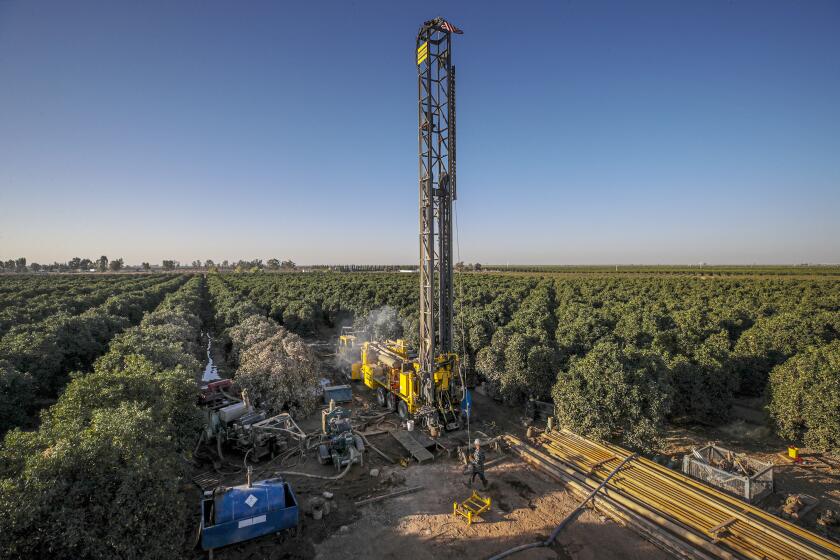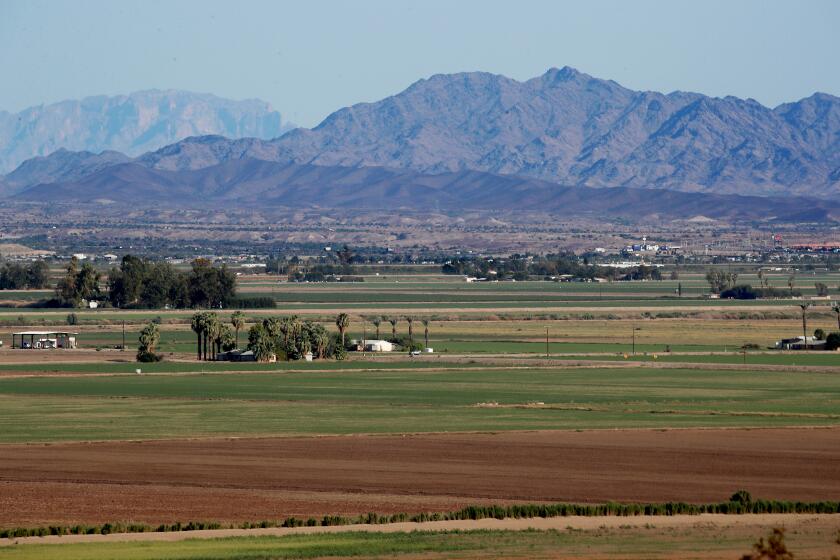Despite California groundwater law, aquifers keep dropping in a ‘race to the bottom’
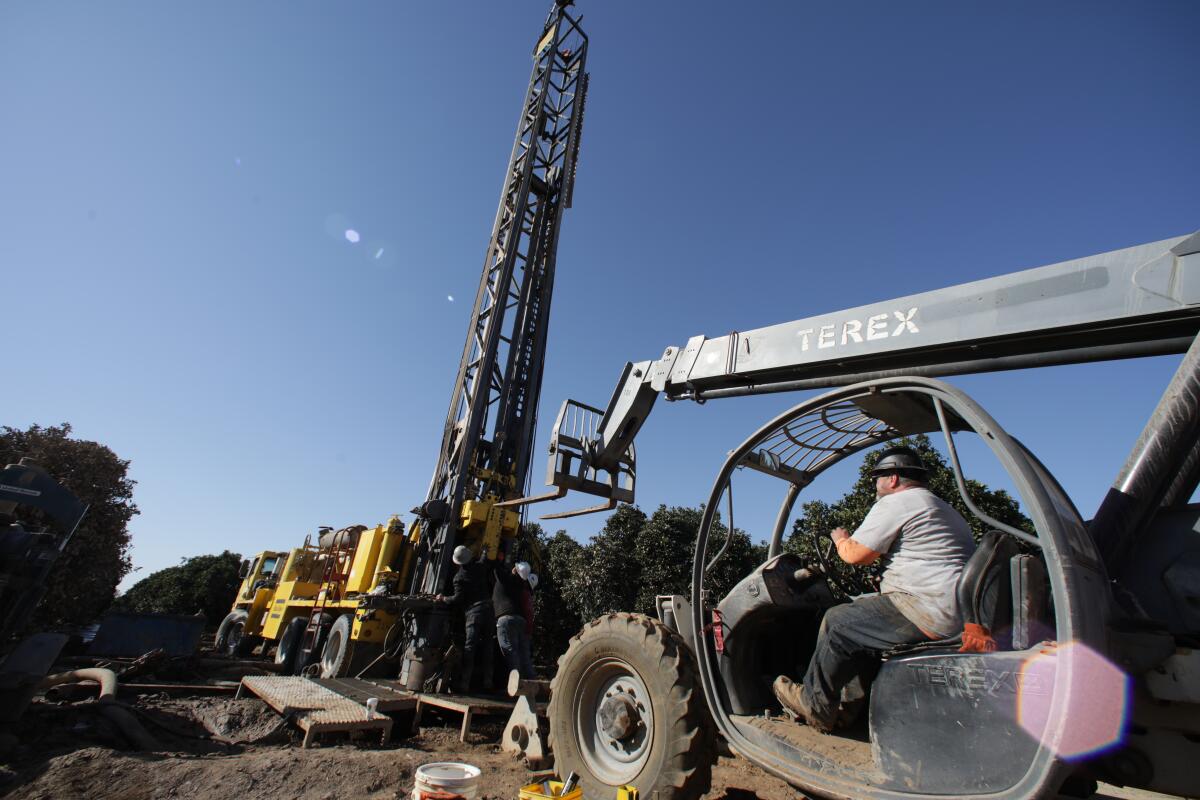
It emerged during one of the worst droughts in California history, when rampant agricultural pumping was causing groundwater levels to plummet and hundreds of Central Valley wells were going dry.
Signed by then-Gov. Jerry Brown, the Sustainable Groundwater Management Act was intended to address overpumping, halt chronic water-level declines and bring long-depleted aquifers into balance.
More than seven years later, however, those goals are still a long way off. The law, known as SGMA, prioritized water management decisions at the local level and laid out a timeline of implementation that spanned more than two decades. Even in farming areas with the most severe problems of groundwater overdraft, the local agencies charged with combating the declines have until 2040 to achieve their sustainability goals.
In the meantime, a frenzy of well drilling has continued on large farms across the San Joaquin Valley. Growers have been pumping heavily during the drought, and groundwater levels have continued to drop. As a result, shallower wells supplying nearly a thousand family homes have gone dry this year. Families with dry taps have been left relying on plastic tanks and trucks that roll through the valley hauling water.
Some of the architects of the legislation now acknowledge it contained flaws.
Despite a California law intended to end over-pumping of aquifers, a frenzy of agricultural well drilling continues in the San Joaquin Valley.
“Looking back on it, probably the timeline was too long,” said former state Sen. Fran Pavley, a Democrat who helped draft the 2014 law. “But who knew there would be another severe drought so quickly? And that people wouldn’t self-manage how much water they were taking out, knowing the impacts.”
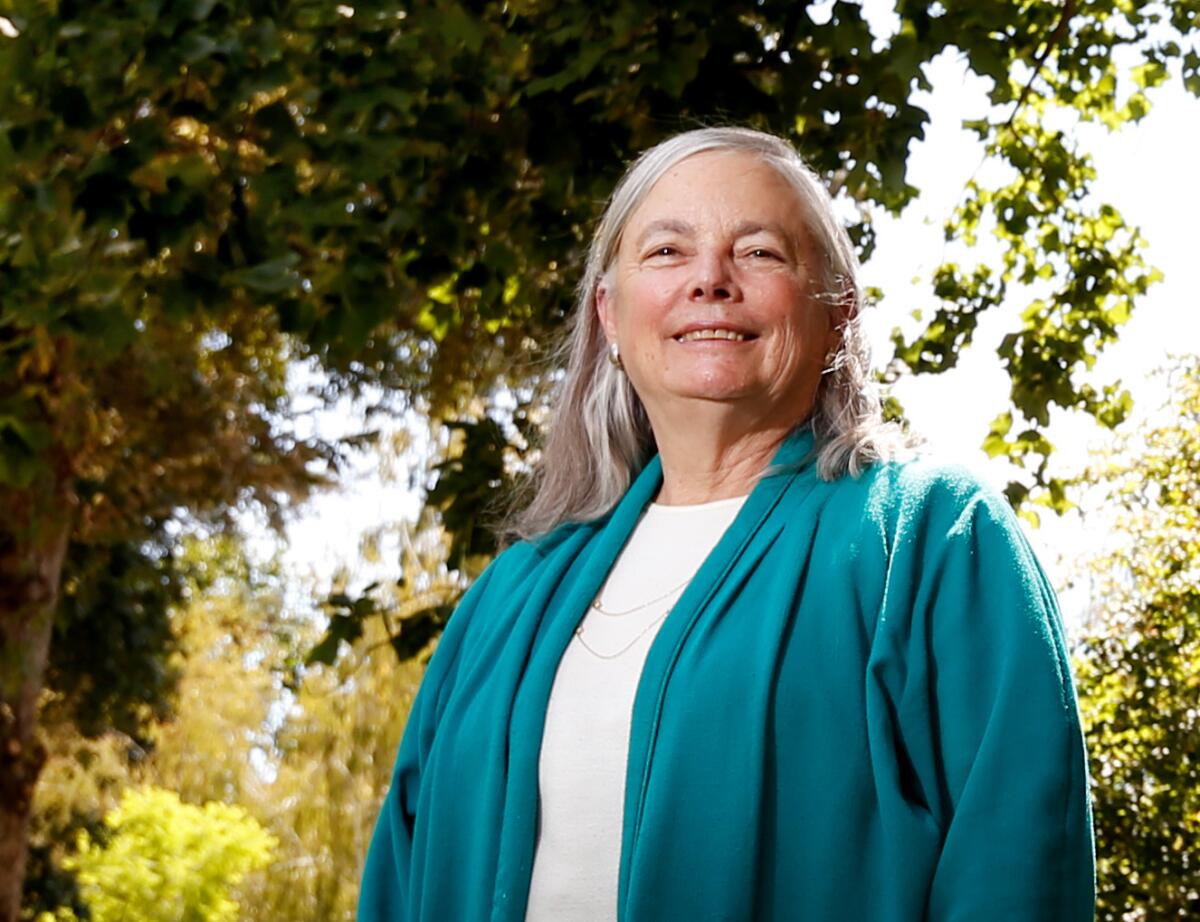
Pavley said she has also been disappointed to see how some local agencies seem to be waiting rather than embracing steps toward sustainability.
“They’re going to wait to the end. And a lot of average people, whether they’re families or small family farmers, are going to get hurt,” Pavley said. “And the state of California is left shipping water to homeowners who can’t compete in the race to the bottom.”
Given the contentiousness of California water politics, the law needed to include compromises, Pavley and others said. One compromise was putting local agencies in charge instead of adopting a top-down system of state regulation. Another was granting the new groundwater sustainability agencies 20 years to reach their goals.
SGMA wasn’t meant to bring about an instant change, said Felicia Marcus, a visiting fellow at Stanford University and former chair of the state water board. It was intended to be “a long-term reach to assure that people’s kids and grandkids would be able to farm,” she said, and to prepare for the worsening strains that climate change is putting on water resources.
As Colorado River levels continue to drop, water agencies are working with local growers to leave some fields fallow in exchange for cash payments.
Marcus said that local water agencies face a massive undertaking in working toward sustainability in 20 years, and that their progress developing plans so far has been encouraging. “There are a lot of them that have actually been working hard and trying,” she said, “even if their plans aren’t quite up to snuff yet.”
The California Farm Bureau opposed the legislation and pushed for making the process locally driven. Danny Merkley, a fourth-generation farmer who lobbies for the Farm Bureau as its director of water resources, said he and others were pleased that the finished product was “much more manageable, much more realistic in what could be implemented in the real world.”
“A lot of people wanted it done yesterday. And I liken it to the Queen Mary. You’re not going to turn it around like a speedboat,” Merkley said. “It’s too big and the consequences would be too devastating.”
State Sen. John Laird (D-Santa Cruz), who was Brown’s natural resources secretary when the law passed, said the timeline turned out to be longer than he would have liked.
“But that’s what it took to pass it,” he said. “I hoped that the time between the enactment and the 2040 date, people would only make progress, that we wouldn’t be stepping back.”
Laird said there has been progress with the creation of local agencies but he has been disappointed by the “continuing drilling and continuing extraction that keeps some basins way out of balance.”
Under SGMA, 260 groundwater sustainability agencies have been formed, and each agency must draft a plan that includes “measurable objectives” and “interim milestones” every five years while working toward the sustainability goals over 20 years.
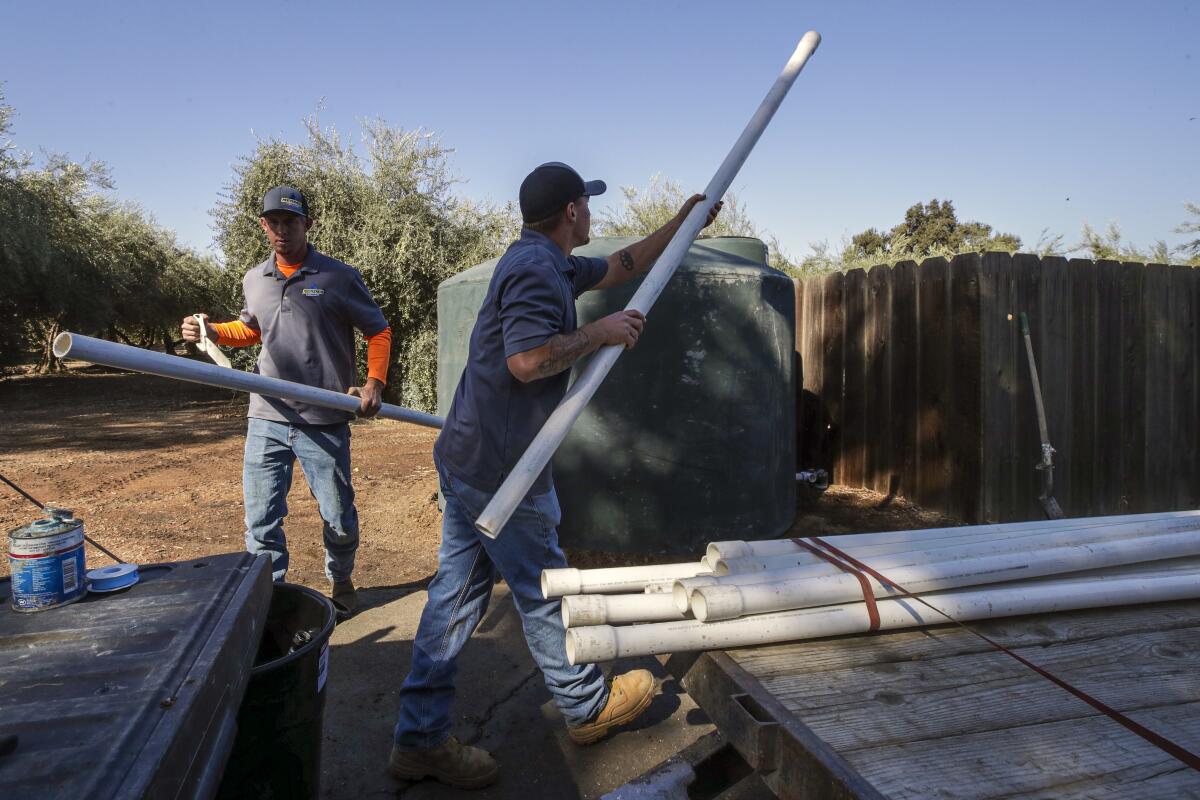
Under the law, sustainable groundwater management is defined as managing water supplies in a way that can be maintained without “causing undesirable results,” such as chronic declines in groundwater levels or “significant and unreasonable” depletion, adverse effects on surface water, degraded water quality or land subsidence.
Sinking ground has become a costly problem in some areas. According to a recent state report, the land in portions of the southern San Joaquin Valley has been sinking as rapidly as 1.5 feet per year. The collapsing ground is affecting infrastructure, reducing the water-carrying capacity of the California Aqueduct, the Delta-Mendota Canal and other canals, which will require expensive fixes. The state has budgeted an initial $100 million for fixing damaged canals.
Under SGMA, the state has designated 21 groundwater basins as being in “critical overdraft.” Of these, 11 are spread out across the farming areas of the San Joaquin Valley.
Researchers with the Public Policy Institute of California have estimated that addressing the groundwater deficit in the San Joaquin Valley could require taking at least half a million acres of farmland out of production. To prepare for this transition, the state this year budgeted $50 million for a land “repurposing” program, to help in converting farmland to other uses.
While local agencies begin to work toward their plans, some observers have warned that many more wells are at risk.
In a study last year, researchers found that thousands of household wells are vulnerable to going dry in the Central Valley. Lead author Rich Pauloo and his colleagues estimated that a “business as usual” scenario of declines would cause between 5,966 and 10,466 domestic well failures by 2040. They found that progressive implementation of plans between 2020 and 2040 would significantly reduce the number of well failures.
As the process continues, Marcus said, state officials have a vital role to play as a backstop, using their authority to step in when local agencies fail. She likened it to the role of an umpire.
“The question is going to be, will the state call balls and strikes the way it needs to?” Marcus said. “They’ve got to make those hard calls.”
State officials have been weighing in when they deem local plans inadequate.
This month, the Department of Water Resources notified agencies in six areas of the San Joaquin Valley that their plans are incomplete, saying they didn’t address how continuing declines in water levels will likely cause many more wells to run dry. The department said many plans also lacked details about how overpumping will probably continue to cause sinking ground and worsening effects on drinking water quality.
“The standard in the law is ‘significant and unreasonable’ effects on their groundwater users,” said Paul Gosselin, deputy director of the department’s sustainable groundwater management office. “I think if you have your water supply shut off, that’s pretty significant.”
Advocates with the nonprofit Community Water Center have called for local agencies to establish programs to mitigate impacts to domestic wells, and for the state to ensure that people aren’t left without drinking water.
“Domestic well users are paying the biggest cost,” said Erick Orellana, a policy advocate with the Community Water Center. Some have struggled to pay tens of thousands of dollars to fix failing wells, he said, “because their neighbor next door is very focused on maximizing their profit on their pistachio farm.”
Orellana said predominantly Latino communities in the Central Valley have been hit especially hard by well failures, yet these residents — many of them farmworkers — have had too little voice in the process as the boards of many local groundwater agencies have been dominated by farm owners and other agricultural representatives. He said that while large corporate farms continue pumping, these Latino communities are dealing with the effects.
“We see that as an inequity and a disparity that needs to be addressed,” Orellana said. “And so we cannot have wealthy white farmers thinking that they have the right to water, they have the right to their land, more so than Latino communities.”
Others are seeking protections for small-scale farmers, who are struggling to cope with the costs of adapting as groundwater levels decline.
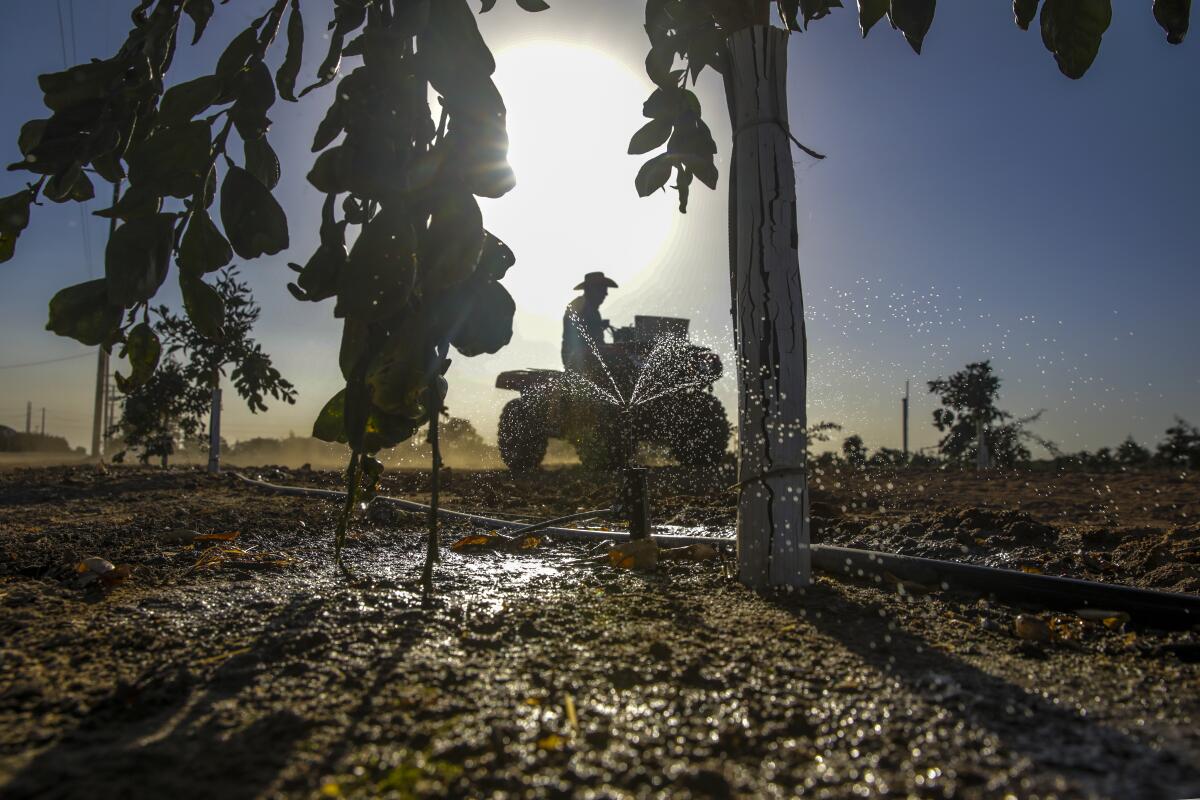
Large farms have planted vast expanses of almonds and pistachios to capitalize on rising global demand. And the unchecked pumping is affecting the wells small farmers rely on.
“There’s no protection for small farmers in the law at all,” said David Runsten, policy director for the Community Alliance with Family Farmers. “They’re being heavily impacted by these investment groups that drill these deep wells and irrigate their nuts.”
Runsten said his organization is seeking to convince state officials to help pay for small farmers’ costs when they must lower their pumps.
Back when the legislation was being drafted, counties insisted on retaining their authority to issue well-drilling permits, he said.
“The result is, people just keep drilling wells and going onto new land and expanding the agricultural footprint,” Runsten said. “People just want to keep doing what they’re doing until they can’t do it anymore.”
